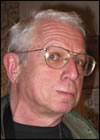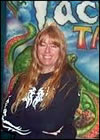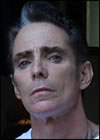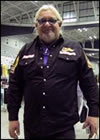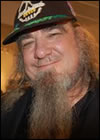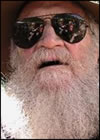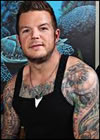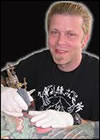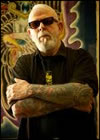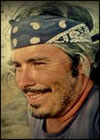|
|
|
|
|
Tattoo Chronicles << 101 Most Influential People in Tattooing << #50-#41 |
Top 101 Most Influential People in Tattooing
The closer we get to the top ten, the more memories are stirred up in my head. Each one of the tattoo personalities listed here has made a significant impression on both me and the world of tattoo. We have six artists, two promoters, two anthropologists, a motorcycle club executive, a couple of filmmakers and several authors. That adds up to more than ten, I know, but this is a multi-talented bunch, which is why they have earned a prominent place on the countdown. I must admit that, the closer we get to the top, the bigger the impact these people had on me, personally. Being the editor of a tattoo publication for nearly fifteen years, the individuals listed here made an important impact on the direction that the magazine took and how my readers perceived the complex world of body art. Maybe in personal ways, maybe in grander, more universal ways, everyone in this segment has inspired me, educated me and made it clear that I had stumbled upon a world so unique, so entertaining, so creative that I will never run out of subjects to write about and stories to tell. —Bob Baxter  |
|
50. Maury Englander (www.mauryenglander.com) has been a Skin&Ink contributor for several years, starting with random “Hipshots” photos of the New York City Gay Pride Parade, several photographic sojourns to esoteric locales in South America and, ultimately, full-blown features on tattooed New York City firemen and Bruce Barts’s memorable Woodstock weekend. “I got my first camera,” recalls Englander, “as part of my bar mitzvah loot, much to my parents’ chagrin. I was thirteen, and about six months later, I sold my first photograph. That’s when my fate was sealed. I lived up in the Bronx across from Bronx Park. It was during the winter and a kid had fallen through the ice in what was the boating lake, a wide spot in the Bronx River. When I found out about it, I went running upstairs and grabbed my camera. Of course, there were police doing all sorts of stuff. They actually didn’t find the body until several days later, but I got a shot of police divers going into the ice. That sold to some local paper up there. I think I got about $20 for that picture, which, back then, was a decent amount of money, considering the camera only cost about twenty-five. I figured I was pretty much ahead of the game. From then on in, I was spoiled for a regular job. I did a lot of political photographs in the early 1960s. It was really, really exciting at all levels. It was almost like another world, compared to today. There were political demonstrations going on, starting with the anti-war movement. Of course, Viet Nam sparked demonstrations all over the county. During that era, I was in Washington, D.C. a lot. I covered various marches on Washington, the Democratic convention and Chicago in 1968. It seemed there was something happening practically every day—sit-ins, lie-ins and be-ins. Civil disobedience of one sort or another was happening. The first tattoos that I photographed—I live on lower Fifth Avenue—we have the Gay Pride Parade coming through every year and I was down there on my front steps and, since I had gotten my first tattoo, I became aware of other people’s tattoos. So, I got my camera and starting photographing people in the parade. That was my first tattoo shoot. From there on, I started photographing tattoo conventions, for no special reason, just because it was so fascinating. It was remarkable therapy from the corporate stuff I was doing. I started shooting for Skin&Ink, after I found a reference to the Mad Hatter’s. I called the magazine and didn’t even know who to talk to. I got hold of you and you said, “Sure, it’s a great little show,” and we got to chatting. I found out that, if I got some pictures, Skin&Ink would be happy to look at them and so I did. I think that was my first Skin&Ink feature, a Hipshots. That’s how I started working for the magazine” Subsequently, Englander is our correspond at-at-large, our own magazine photojournalist photographing the tattoo scenes from South America and India to the colorful environs of Brooklyn, Queens, Staten Island, Manhattan and The Bronx. His ongoing tattooroadtrip.com feature, “Maury’s Neighborhood,” is a welcome addition, not only to our Daily Blog, but also serves as a reminder that tattoo art is wherever you find it; whether it’s on the other side of the world or right next door. |
|
49. Judy Parker (www.judyparker.org) says her shop, in San Diego, California, is in the ghetto. Sure, it’s on the wrong side of the tracks and pretty remote, but there’s a well-groomed golf course across the street. “It’s for the Navy,” said Judy. “Every once in a while, a golf ball breaks my windshield. But that’s all right, because the military pays for it.” That’s good news. Judy, quiet and girlish, with a mischievous twinkle in her eye, runs a clean shop on a street with no foot traffic. Charming and shy, Judy keeps her distance from both the center of the San Diego tattoo scene and mainstream tattooing as a whole. The way I heard about Judy Parker was through her flash, and, according to Judy, drawing was a way for her to get her foot in the door. “Initially, I didn’t think my tattoo skills were as high as my art skills, which is why I did a lot of flash. I started getting known because of my flash. I think people took me a lot more seriously than I ever took myself. I never really wanted to tattoo. Steve, a tattoo artist in Alaska, just thrust it into my hand. I had never seen tattooing done before that. I never took it seriously, due to my religious background. And because I didn’t take it seriously, I misstepped and missed out on all the training I could have gotten. I didn’t think it was a serious career. I was seventeen, and, to me, it was a laughed-upon kind of thing. My dad was very, very harsh. He though of me as the top…of not a very good heap. He put tattooing in a very bad light, and still does. I’m the black sheep of the family. Consequently, I didn’t take tattooing seriously for many years. Even when I was working for Doc Webb. I figured I wasn’t top dog, and didn’t consider myself knowledgeable. I started going to conventions in 1990. That’s when I finally realized tattooing was important and did have some value. It wasn’t just a carnival sideshow thing and actually had merit. I didn’t get trained until people from conventions began taking me under their wings. People like Sailor Moses and Jack Rudy actually told me how to do it better. A lot of people know me because of my flash. I was told to do flash from the beginning. When I worked for Al Orsini in San Diego, I did flash for $5 a day. I had returned to San Diego to be near my mother and go to college to become an art teacher. That didn’t work out, so I walked into Doc Webb’s and asked him for a job. He was a really nice guy. He treated me really good. That was 1981. I only worked for Doc Webb for a couple years, because Jim Gunkle was getting annoyed. All the sailors were coming to me. They didn’t want the guy with the big cigar tattooing them. They wanted the young girl. Then I worked for Al Orsini for a while. He had three shops: Gene’s Tattoo Shop, Thunderbolt and One Stop. Then I opened my first shop, Blue Dragon, in 1984. It was at 31st and Main. Right up the street. I opened my current shop, Judy Parker’s Pacific Tattoo, in 1994. Through all of this, I got no support from my family. None. The tattoo community has taken over that role—so much so that I feel I could stop anywhere, if I had any kind of problems, and stay at their homes and be part of their family. I have a very warm feeling for my tattoo family.” Jack Rudy once told me that, “If the entire tattoo thing were to disappear tomorrow, Judy Parker would be the only one to be able to survive, due to her graphic arts skills.” High praise indeed, for this “woman in a man’s world,” who, even though she prefers to remain “under the radar,” made a name for herself in a highly competitive town, in a highly competitive industry. |
|
48. Mark Mahoney (www.shamrocktattoo.com) opened Shamrock Social Club on Sunset Blvd. in 2001. It was an instant landmark. As Dani Oberosler relates in her biography of Mark, “Mahoney, an icon in the business, had his own shop. The tattooists that work there are heavy hitters, the floor is tiled with an Irish flag. And once Shamrock opened, it became a staple of the Hollywood scene. Everyone knew, a night on the town wouldn’t be complete without a visit to the Social Club. Mahoney has been tattooing for over thirty-five years. He’s known for his detail and perfect, fine lines. He looks like he walked straight out of a big band era movie, but he’s a hardworking family man. Visit his shop on St. Patty’s Day and he’s gushing with Irish pride. Mark Mahoney grew up just outside of Boston, the nation’s second largest Roman Catholic archdiocese. Being raised Irish Catholic helped shape Mark’s dreams as a boy. ‘I thought I was gonna be a priest, up until I was about twelve. Then I wanted to be a secret agent. And then I wanted to be a tattooer.’ Mark grew up with two older sisters and considers his childhood relatively normal. His earliest memory of tattoos was a lasting one. ‘I remember being on Revere Beach with my father, and he runs into one of his old Irish cronies. I think he was an Irish gangster guy named Silky Sullivan. He had a big pinup girl on his calf. I remember checking it out, chi-chis and everything. I was fascinated. It had a profound effect on me. I thought it was cool.’ Graduating from high school, Mark tried to enroll in the School of the Museum of Fine Arts in Boston, but was sidetracked after only three months. ‘All my new friends from school were moving to New York, so I did, too.’ Mark’s parents were not receptive to his desire to tattoo. ‘It was an issue with my parents, because tattooing was illegal in Massachusetts. It went over like a fart in church, as they say in an Irish family. It was kind of rough, and it took a long time before they realized it was a legit business. Tattooing is a far cry from priesthood.’ Mark’s parents have since passed away, but he feels that they came to accept tattooing as the best and only choice for him. ‘I think they realized I found what I was supposed to be doing.’ Mark began tattooing in 1975. ‘I started getting tattoos, when I joined this little gang. We dressed like the ’50s, you know, a little gang of greasers. And this guy Mark Herlihy, he was the leader of the pack. He joined the Navy and learned how to tattoo. So, he comes back from the Navy with a bunch of tattoo equipment and tells me I’m going to tattoo his back. He had learned a little bit about the game and so he taught me. He’s still at it and has a cool little one-man shop in New Hampshire. He gave me my start right there, tattooing a tiger on his back. Mahoney opened an earlier version of Shamrock, around 15 years ago. ‘It was on Third Street and Sweetzer. I went into rehab, and the guys kinda ran it into the ground while I was gone. When I got out, Gill Montie gave me a job at Tattoomania on Sunset Boulevard. I worked there for eight or nine years.’ Mark waited a decade before opening another tattoo shop. ‘I was having a good time at Tattoomania and I love Gill. I was going to try and buy it from him, but, at the last minute, I got kinda out bid, so it didn’t work out. There were a couple more years where I was waiting to find a spot.’ In 2001, Mark opened his second Shamrock, this time a self-proclaimed social club. ‘I was supposed to sign the lease on September 11, but then that shit happened,’ referring to the collapse of the Twin Towers in New York, ‘and so they called and said we had better put that appointment off until tomorrow. I’ll always remember, things started with a bang at Shamrock.’ Mark has tattooed his fair share of celebrities. Located on Sunset Boulevard across the street from the Rainbow and Roxy, he’s seen it all. Even the decade he spent just down the street at Tattoomania is right in the hub of Hollywood nightlife. So, it’s no surprise to hear that Mark has been asked to tattoo at the home of uber-celebs like Brad Pitt and Angelina Jolie. Mark’s career spans three decades. He’s been in all the right places at pivotal times in tattoo history, from the underground punk tattoo scene of the ’70s, to the Pike, the black-and-grey movement of East L.A. in the ’80s and the decadent Hollywood lifestyle of the ’90s. It’s anybody’s guess what the future holds, but whenever history is being made in the tattoo world, it’s guaranteed that Mark Mahoney will be in the thick of it.” |
|
47. Steve Bonge, aside from being a heavily-tattooed biker and vice president of the New York City chapter of the Hell’s Angels, is an important documentarian, having provided, in his books Tattooed with Attitude and Marked for Life, rare, insider views of the international tattoo scene, for well over three decades. Trained at Nassau Community College and Manhattan’s School of Visual Arts, Bonge is not only a successful lensman, but also a sculptor, designer, tattooist, actor, collector, historian and co-promoter of the annual New York City Tattoo Convention, one of America’s last remaining old-school tattoo events. According to Charles Gatewood, “In the mid-1970s, when Bonge began to document the New York tattoo scene and the outlaw biker lifestyle, his passions weren’t widely shared outside his small circle of underground friends. From the beginning, Bonge made it his mission to photograph numerous old-school tattooists like Paul Rogers, Bob Shaw, Doc Webb, Bill Skuse and Lyle Tuttle, plus such illustrious pioneers of America’s tattoo renaissance as Spider Webb, Ed Hardy, Bob Roberts, Gill Montie, Jack Rudy, Brian Everett, Jonathan Shaw, Mike Malone, Greg Kulz, Bill Salmon and more. In these passionate, workmanlike images, Steve Bonge has given us a solid look at the New York tattoo/underground scene, as well as tattoo personalities and events around the world. Bonge’s best pictures not only show the special magic of ink on skin, they also capture the way-colorful personalities of his amazing tattooed subjects.” My first experience with “tough guy” Steve Bonge was at his New York City Tattoo Convention. We had a bit of a run-in: I used a couple girls from the floor to hand out free copies of my magazine to the crows that roamed the aisles. Bonge came up to me and asked how “his girls” were going to be paid for their time. Not used to carrying a wad of cash in my pocket, I told him that I would send the girls a check signed by my publisher, Larry Flynt. A lot of people thought that was a “big deal,” to receive a check from Flynt himself. But Bonge disagreed. “Pay them cash,” he said. “Now, not later.” It kind of shook me up, at the time. But, after going to a ready-teller down the block, I realized that Bonge was right and that he was only protecting a couple young women from being ripped off by me, a relative stranger. He may be a “tough guy”—Hell’s Angel, and all—but, as years passed, I had a couple more situations where Steve proved to be aware, compassionate and understanding, like when I was covering his convention in Long Island, the day before 9/11. Because of logistics, I had missed breakfast. When Bonge overheard that, we quietly slipped me half his sandwich. He didn’t have to and probably could have turned a deaf ear. But he didn’t. Which, along with his formidable list of talents, is why he deserves a place on this list. |
|
46. Clayton Patterson (patterson.no-art.info) is one of the organizers of the annual New York City Tattoo Convention (2010 marked its fourteenth year). A successful artist, Patterson arrived in New York in the late ’70s and became a well know part of the Soho art scene and was one of the first to open an art gallery on NYC’s Lower East Side. “I came to New York from Western Canada,” says Clayton. “I was always interested in alternative art, ‘outsider art’ and art outside of the mainstream. One day, I saw an ad on the back page of the Village Voice about a meeting of the Tattoo and Body Arts Society in a gallery on East 6th Street, and I started going to their get-togethers. Remember, tattooing was illegal in New York City then, so this was more of a social club, a gathering of people who shared an interest in body arts. Soon after that, the owner of that gallery decided he didn’t want to host the meetings anymore, and the whole thing was falling apart. I hooked up with a guy named Ari Roussmoff who wanted to keep it going and we sort of took it over, re-naming it ‘The Tattoo Society.’ This was around 1986. We would hold meetings at clubs around the Lower East Side and bring in artists like Shotsie Gorman, Mike Bakaty and Big Joe from Yonkers to give talks and show slide. What helped make it successful is that Ari and I were not in the tattoo business, so we weren’t part of the competition: we were interested in the art of tattooing, the culture and the people.” Back around this time, a number of prominent tattoo artists working here, who also came from a traditional fine art background: Cliff Raven studied art in Chicago; Ed Hardy was trained as a print maker; Spider Webb and Mike Bakaty had Masters Degrees in Fine Arts. And the art scene was exploding at the same time. By the ’80s, that number had grown to tens of thousands of artists living and working here. The Lower East Side suddenly had over one hundred galleries.” In an ironic twist, the stock market collapse of 1987, while devastating to this blooming art world, provided a new impetus to the tattoo world. “All of a sudden, we had all these well educated, talented artists with no place to go to make a living. A lot of them were attracted to tattooing, but, in NYC, tattooing was still an illegal, closed world. Illegal or not, the tattoo scene was growing in NYC. Many young artists were exposed to the art form for the first time at Tattoo Society events. Some went on to learn by apprenticing while others were self taught. “In the late ’80s, there was suddenly this big wave of new, young artists who nobody had ever heard of before. Folks like Paul Booth, Sean Vasquez, Michelle, Andrea Elston, Kate Hellenbrand and Daren Rosa were now part of the scene. Wes Wood, who had been a printer, became the ‘technical person’ in the mix. He went on to create Unimax, marketing tattooing and piercing equipment and supplies. Many of Charles Gatewood’s photos were shown for the first time. By the early ’90s, while still illegal, tattoo artists were openly at work in New York City. There were ads in local papers and some underground shops even had signs out front. Clayton and Wes Wood became involved in the move to get the law changed. “Guliani was just coming into office: he was a real law-and-order guy, who would shut down tattooing. Actually the City classified tattooing as a ‘medical misdemeanor,’ which meant it was legal for doctors to do it, but not artists! So, we finally got all these tattoo artists together at a meeting. You have to realize this was a phenomenal event: all these people at the same table. And it was a big table!” Much organizing, meetings with Health Department folks, politicians and artists and lots of hard work later and the law was finally changed. Clayton, along with being a key player in making tattooing legal again in NYC, joined with Wes Wood, Steve Bonge and Butch Garcia to create the first New York City Tattoo Convention. |
|
45. Don Deaton entered the world of tattoo in 1970 as a gopher/apprentice at Bert Grimm’s World Famous Tattoo Shop on the Long Beach, California Pike. Working among legendary artists like Bob Shaw, Lou Lewis, Colonel Todd and Grimm himself, Deaton’s forty years as a tattoo artist has translated into a seemingly endless string of classic stories about the old days, before tattooing was big business and TV shows featured soap opera scenarios, rather than fact. Portland, Oregon isn’t as action-packed as the Pike in the ’70s, and, today, tattoos are much more commonplace, but Don is still a major player in the tattoo culture. He fondly remembers an era when shops were confined to a certain area of the city and tattooists were true pioneers in their field. According to one of his biographers, Carmen Forquor, “Don first considered his apprenticeship at Bert Grimm’s as just another odd job for extra cash. He never anticipated becoming a tattoo artist. Growing up in Long Beach, Don enjoyed sketching comics and was known to draw ‘tattoos’ on his friends. His favorites were Popeye or a jaguar with blood dripping from its claws. He even entered art school for a short time after high school, but then decided to join the Army. He later resumed his college career at Cal State Long Beach, but, this time, as an English Literature major. Here he met Rio DeGanerro, the son of Lou Lewis. During this time period, Don described himself as a ‘professional student,’ switching from one job to the next—taxicab driver, delivery person—and, finally, after much nudging from Rio, became an apprentice at Bert Grimm’s. Not serious at all about tattooing, his real love was drawings comics. Don only took the job because he enjoyed the people. He was perfectly content to be the shop gopher and simply soak in the atmosphere. As it goes, Don did a lot more mopping and coffee pouring than he did tattooing. Even though the Pike was past its prime by the 1970s, it was the only legal place to tattoo, so the shops were really crowded together. Consequently, resorting to dirty tricks was standard procedure. Causing another shop to be fined by sending in underage kids was a typical ploy. Shooting at each other’s business signs with 22s was also par for the course, but there were times when they pulled out the big guns. Don remembers that, one night, things got pretty heated. A small, scrawny guy dressed like an Apache dancer and his partner were hassling a large, burly guy’s wife. Being low man on the totem pole, it was up to Don to take the men outside and calm them down. But, before he knew it, the little guy was flying right through the shop’s front window. There was blood everywhere. A stunned Don hurried inside to call for an ambulance but, by the time it arrived, both men ran away. After some head scratching, they finally figured the two men were Hollywood stuntmen, the blood was fake and the whole incident was staged by Capt. Jim, who ran a shop across the way. In 1974, Don went to work with Capt Jim. He spent the next four years tattooing with some really great artists and, even though he never tattooed with Bert, he worked in Grimm’s shop, the oldest operating tattoo establishment in the world. In 1978, Bert had been tattooing on Portland’s Burnside Street and, because of ill health, wanted to sell his shop to Bob Shaw. Both Bob and Col. Todd ended up buying it. Col. Todd wanted to stay in Long Beach, so he propositioned his son, Dave Orlowsky, and Don to move up to Oregon.” After I visited Don’s shop on my first sweep through the Pacific Northwest, I relocated to Portland several years later, but Don hadn’t forgotten me. In fact, after a brief phone call from Los Angeles, Don and his crew met me and my wife at our new home, unloaded the moving van in the rain and has constantly kept in touch via his notes of well-wishes and intricate tales of the days when tattooing was less sophisticated and more like the Wild Wild West. The history and the legends never fade. They are alive today because of the great storytellers who lived among ’em. Storytellers like the incomparable Don Deaton. |
|
44. Deano Cook (www.psychotats.com) made his mark by transferring underwater photography to skin art. Back in the day, when tattoo studios looked more like motorcycle repair shops, Deano started to tattoo full-color portraits, when others were focusing on black & gray. Working out of Psycho Tattoo, Deano’s “dentist-office-on-acid” in Marietta, Georgia, every tattoo station his it’s own TV and sound system with earphones, every corner, from the waiting area to the piercing room is meticulous, clean and modern. While the predominant theme is marine life (there’s assorted aquariums and snippets from Deano’s amazing underwater photography on flatbed TV monitors, wherever your eye wanders), the most striking element is the efficiency. Deano has it just the way he wants it. Much of this is due to his brother, Russ, however, the star of the show is clearly the sun-tanned, fit and athletic, Deano Cook himself. While it is clear that he is currently crazy for anything aquatic, Deano has been a lover of the ocean since childhood. He had an uncle who started him out, crabbing, fishing, snorkeling, doing a lot of activities around the ocean. “My love for it developed, literally, when I was still in diapers,” recalls Deano. “My uncle already had me out doing things in the bay—he had a house in Florida—so it’s always been a strong passion of mine. It wasn’t until a little way into my tattoo career that I figured out how to marry the two together. This was a purposeful tactic on my part, to keep me doing something I love. The one helped me perpetuate the other. Now there’s a blurry line between when I’m working and when I’m playing. Because of it, all my vacations become part of my work. I dive and do underwater photography, and it all adds to my image bank, my reference library.” Up until Deano came along, the predominant underwater tattoo subject were mermaids or an octopus, the one where the tentacles are wrapped around a shark or a giant squid. You saw it over and over. And then we started seeing Deano’s tattoos of marine life, plants and coral. he was the one that started to bring in all the diverse aquatic elements to tattooing. “I found that a lot of the techniques I had learned by doing portraiture were very applicable to marine tattoos. I see a lot of sea life in which the colors are very cartoonish, so it’s very easy to slip into a style in which those elements have a cartoony look to them. Other artists tend to do it that way, and there’s nothing wrong with that, it’s just that I prefer a more realistic look. For years, I was one of the few people doing color portrait work, and it really helped in making the crossover to creating tattoos of marine life.” While many artists have a problem with tattooing and painting at the same level of excellence (they often say that it’s the great difference in the tools), Deano is equally adept at tattooing and painting huge, one-hundred-foot-by-eight-foot murals on the sides of enormous buildings. Wyland is the leading marine life muralist in the world. He was the official artist for the 2008 Olympics. He painted his hundredth wall in Beijing just for the Olympics. He did the roof of the Long Beach Convention Center to promote the Disney movie Earth for Earth Day, which is the world’s largest portrayal of earth on top of the Convention Center. He’s not just going to put someone on these massive, literally world-record-sized murals with someone who hasn’t the appropriate skill or knowledge. But the very first one he did with Deano established a world record. “The size aspect is overwhelming,” says Deano. “We were painting everything from a whale to little, tiny fish. We did a Blue whale that was life-size. That’s a hundred-and-five-foot subject, and Wyland doesn’t use any pre-sketching or grids or anything. It’s all just free-handed up there.” Deano has four shops. Two of them have been around eight years, one twelve years. The Marietta shop has been around fifteen years, but having four shops to oversee and solid customer bookings for the foreseeable future, he still has a slight, unresolved problem. “I’m very busy here, says Deano. “Because of that, I miss doing more fine art. But that’s really a good problem to have,” especially from someone who entered a field jam-packed with great artists and was able to establish himself in a particular niche that no one, before or after, has been able to duplicate with such skill and dedication. |
|
43. Aaron Bell (www.slavetotheneedle.com) was a big help in putting together my first Tattoo Road Trip book about the Pacific Northwest. I was by myself, driving from town to town, visiting shops, gathering information and shooting pictures. I gave Aaron a call at his first shop, Slave to the Needle, in Ballard, a busy neighborhood on the outskirts of downtown Seattle. Aaron was one of the people I planned to see after discovering his work, as I was pulling together the last issue of the magazine. I was sorting through the photos marked Artists and Their Rides, and I came across one of blond fellow standing in front of a tricked-out ’52 Merc with flames. It was Aaron Bell. Not only did his photo catch my eye, so did his address. And since the only person I really knew in Seattle was Vyvyn Lazonga, discovering Aaron was quite fortuitous. Plus, if memory served me right, when I talked to Vyvyn a week or two before, she mentioned Slave to the Needle did great work. So, there I was, navigating the streets of Seattle, listening to Aaron’s directions on my cell phone. When I finally arrived at the shop, he and his crew were waiting. Then, after queuing up eight or ten of their best customers for photos, they offered to take me to dinner at the famous Space Needle. Fun in the big city. In fact, right in the middle of dinner, the waiter came over to us and said that a customer at another table wanted to know if we were rock stars. “Yes,” I said. “We’re Queen.” From there, Aaron and I developed a close relationship. He was a columnist for my magazine, a cover artist and was always a welcome host, whenever I visited Washington State. But more than that, I watched Aaron grow and establish himself as one of the best all-round tattoo artists of the last decade. Aaron started tattooing in 1993 and, in 1994, received an apprenticeship. A constant award winner for his portraiture, traditional and Japanese tattoo designs, Aaron has served as host of multiple National Tattoo Association conventions and, now, owns two shops in Seattle. Quiet and somewhat shy about confrontation, Bell nonetheless is very opinionated about the direction the art form has taken in the last decade and has, through his tattoos, cover art, travel ethic and two elegant shops, reached an enormous international audience, helping to lead the way in establishing clean, clear, powerful tattoo images as a standard with tattoo artists in both the U.S. and abroad. |
|
42. Bob Roberts , (www.spotlighttattoo.com) scares the shit out of me. Here’s the way I figured it: If Bob Roberts does my tattoo, we’ll have a special bond. So, he did one of my first major ones, on my forearm. One of his tattoos, makes us almost family, right? I’m not saying Bob Roberts is a bad person. Hey, they used to call him “Buffalo” Bob and he played saxophone with Ruben and the Jets. It’s just that Bob upends my rhythm. I ask him a question, and he’ll just stare at me. Like he’s sizing me up. It makes me nervous. I function best with lots of feedback. A cheery smile. A nod of the head. A giggle. Bob doesn’t do any of that shit. It puts me in a cold sweat. When he does that silent thing, I come unglued: Is he studying that mole on my face? Is he thinking what a jerk I am to have a mole on my face? Does he know I have trouble shaving around it every morning? Does he see that little patch of stubble? My guess is that Bob is coming down from a creative high. I know when I’m writing and someone comes into my office, it takes me a few seconds to adjust. To come back down to earth. Not a good time to drive heavy machinery. Maybe it’s the same with Bob Roberts. Maybe he’s coming back to reality, to shift gears—before he talks to the idiot with the mole.I work best when people respond. I don’t do well with people who, when you ask them a question, look you right in the eye and say nothing. Larry Flynt does that. Bob Roberts does that. In Mr. Flynt’s case, even though I edited one of his magazines, I don’t know the man on a casual basis, and we have no point of commonality. Why anyone would want a tattoo? That’s what he’s probably thinking. But, Bob Roberts, he’s just being honest.He’s not interested in pussy-footing around. When he’s quiet, he’s quiet. But when he gets started, he takes no prisoners.Communication is not his problem. My lord, Bob Roberts is one of the most interesting, articulate men I’ve ever met. Once he gets rolling, you have to take notes. He’s a wealth of information, double-entendres, racy stories and history lessons—enough to choke a college professor. It’s his aura that’s unnerving. It’s his ambiance. His pedigree. He’s worked side by side with Cliff Raven and Don Ed Hardy, for heaven’s sake! Plus a stint with Colonel Todd at the Pike. If that isn’t enough, Bob was the man to take over Bert Grimm’s chair when Bert left Orange County. No two ways about it, Bob Roberts is the real deal.I also chose Bob the artist. Without qualification, he’s the best. I told him I wanted a skull with a banner that said love hurts. Bob said, “No. Instead of words, I’ll say ‘love hurts’ with the tattoo.” And that he did. Up one side and down the other, he drew a skull and dagger, surrounded by flames. The eyes, nose, handle and entry point—five broken hearts. The point of the dagger points outward, protecting me against further episodes. He knows, probably better than anyone, how to interpret an ideas into art. His designs have impact. They’re uncomplicated in their complexity. They’re bright and clear. They stop you in your tracks from ten yards away. They are what classic tattoo art is all about. |
|
41. Dr. Lars Krutak (larskrutak.com) is an American anthropologist, photographer and writer known for his outstanding research concerning the art of tattoo and its cultural background. Although his credentials and biography abound with accomplishments and academic achievements, Lars, to me, has done as much or more than anyone in the world of tattoo to establish its credibility, its meaning and its history than anyone alive today. He is also the most prolific. Whenever I have asked Lars for a story, he sends ten. When I ask for a couple of photos, he provides fifty. With the glut of meaningless and badly-conceived television programming on the air today, Krutak produced and hosted an outstanding ten-part documentary series Tattoo Hunter on the Discovery Channel, in which he traveled the indigenous world to showcase vanishing art forms of body modification. Lars currently works in the Repatriation Office of the Smithsonian Institution’s National Museum of Natural History in Washington, D.C. Lars was born in Lincoln, Nebraska to a traveling geologist and university professor, who moved the family to Mexico City in 1979 and then to a series of states including Louisiana, Texas, and, eventually, Colorado, where he grew up in the small mountain town atmosphere of Rye. Krutak attended the University of Colorado at Boulder, studying art history and anthropology and, upon graduation, in 1993, moved to San Francisco to work as an art gallery preparator for Paul Thiebaud, the son of American Pop artist Wayne Thiebaud. In 1996, Krutak attended graduate school at the University of Alaska at Fairbanks, where his thesis One Stitch at a Time: Ivalu and Sivuqaq Tattoo focused on the tattooing traditions of the St. Lawrence Island Yupik people. Krutak briefly attended Cambridge University as a Ph.D. student in 1998, but he returned stateside to work at the National Museum of the American Indian (Smithsonian Institution) where he worked as a Repatriation Research Specialist (between 1999–2002) facilitating the return of sacred and ceremonial objects and human remains to indigenous peoples throughout North America and Mexico. Between 1998 and 2003, he also worked for the OSCE as a Democratization Analyst in several countries of the former Yugoslavia, monitoring electoral reforms. Since 2002, Krutak served as an Anthropological Consultant for three National Geographic Channel productions and was a co-recipient of the 2003 American Book Award in Literature for Akuzilleput Igaqullghet, Our Words Put to Paper Sourcebook in St. Lawrence Island Yupik Heritage and History. His Ph.D. studies at Arizona State University (2005–2009) focused on the socioeconomic impacts of tourism on the Rarámuri people of Mexico’s Copper Canyon region. In his continued effort to understand how tattoos and other forms of body modification “make” the people who wear them, Lars has acquired many traditional tattoos including hand-tapped work from the Iban of Borneo, Kalinga of the Philippines, Mentawai of Indonesia; hand-poked tattoo art from Theravada Buddhist monks in Thailand; and hand-pricked designs from the Kayabi of the Brazilian Amazon. He also wears approximately one thousand razor and knife-cut scars across his body received from other groups like the Kaningara of Papua New Guinea, the Bétamarribé of Benin,the Hamar of Ethiopia and the Makonde of Mozambique. Oh, and did I mention that he has a terrific sense of humor? Well, he does, and that is one more reason I am proud to include him among the major contributors to the living history of world tattoo art. 
Tattoo Chronicles << 101 Most Influential People in Tattooing << #50-#41 |
|
|
|

